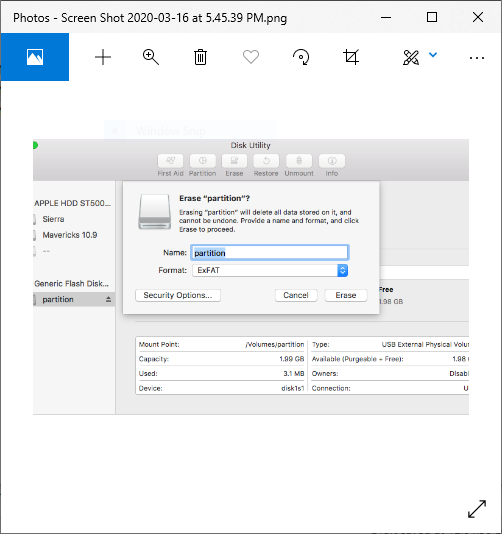
- #How should internal hdd for mac be formatted with sierra install
- #How should internal hdd for mac be formatted with sierra drivers
- #How should internal hdd for mac be formatted with sierra mac
- #How should internal hdd for mac be formatted with sierra windows
#How should internal hdd for mac be formatted with sierra install
Boot to Installation Screen> Utility>Disk Utility and see if the SATA HDD is seen there to Partition, Format and Install Sierra.If the drive is internal, it should already show up in. Turn the drive on, and make sure it appears in the Finder. On reboot F12> UEFI USB Installer >Clover Boot Manager To format an external storage device, connect it to one of the ports on your Mac.Disable all other options from Boot sequence.Select Sierra UEFI USB installer first boot.Make the BIOS options for Hackintosh Clover UEFI boot loading.Power ON, Load Optimized Default BIOS and Reboot.Power Off and check all connections inside the case and keep only the target SATA HDD connected.Have you made sure the SATA Power and SATA Data cables to the Target SATA HDD are connected and well seated?If you are not ABSOLUTELY SURE: ( some Power Cable connection may appear to be inserted but may actually be 'touch&go", some SATA cables with no retention clips are similarly unreliable).Do you have any other SATA HDD connected to the System other than the Target SATA HD for Sierra System?.Downloaded macOSSierra from Apple Store and saved it in Application folder only.
#How should internal hdd for mac be formatted with sierra mac

#How should internal hdd for mac be formatted with sierra drivers
When you installed Sierra to a SATA HDD using a SATA to USB 3.0 Adapter or Dock, the System treated it like a USB HDD or FD installing drivers to access that disk. As you get closer to 8TB of storage, you’ll be looking at spending $150 or more.Building a CustoMac Hackintosh: Buyer's Guide You won’t be able to find many quality HDDs that hold 4TB of space for under $100. If you’re looking for anywhere between 2TB and 3TB of storage space, you’ll be spending within this price range. In this range, you’ll find quality external drives that hold 500GB to 1TB of storage for Mac computers. Overall storage space will typically play the main role in the final price you’ll pay for an external hard drive. Their max transfer speed is about double that of USB-C at 40 Gb/s. Their strength is in their speed and power as well as their ability to chain more than one device to a single computer. Thunderbolt connections are the latest in data and power transfer, and they are popular amongst Mac devices. External HDDs that are not specific to Macs may also work, but you’ll need to reformat them first, which could take some time.Įven though Mac computers are capable of reading hard drives that are formatted for Windows, if you intend on using your external HDD as a bootable disk or want to use it to backup files with your Mac’s Time Machine, you must format it to be entirely Mac compatible.īestReviews Electronics Expert Thunderbolt This is because when you initially connect an external HDD made for Mac (to a Mac computer), you won’t be required to format it before you begin transferring files. Key considerations Formattingįor Mac users, buying an external HDD already formatted for your system makes getting started much easier. Macs running OS 10.5 and higher - Leopard to Yosemite - include the Disk Utility program that allows users to check and repair disks and drives and to format. You can repurpose any hard drive to work with your Mac.

#How should internal hdd for mac be formatted with sierra windows
There are varying levels of storage capacity in an external hard drive, and the overall size of the HDD depends on the model. Mac-formatted external hard drives are often priced higher than their Windows counterparts and are not as widely available. Others will need to be plugged into the wall. Some external hard drives get power directly from the computer connection. Flash drives are external drives, but they aren’t as fast, and they don’t usually store as much space as their larger external hard drive relatives. flash drivesĮxternal hard drives are basically hard drives (HDD) or solid state drives (SSD) that are wrapped in their own protective casing and connect to your computer from the outside as opposed to the inside.

There are hard drives that may hold volumes like 3TB, 6TB, and 10TB, but they are much less common than the standard hard drives that hold: 1TB, 2TB, 4TB, 8TB, and 18TB.


 0 kommentar(er)
0 kommentar(er)
